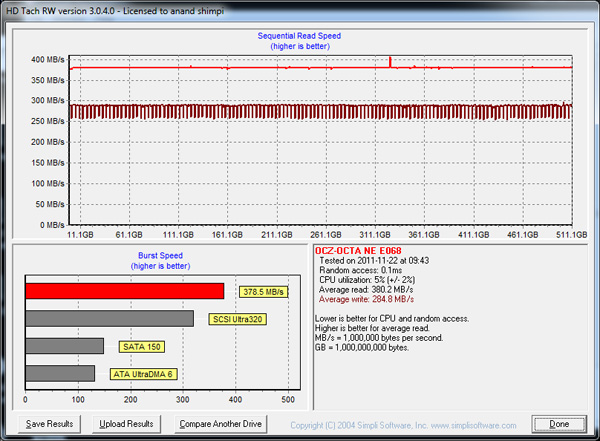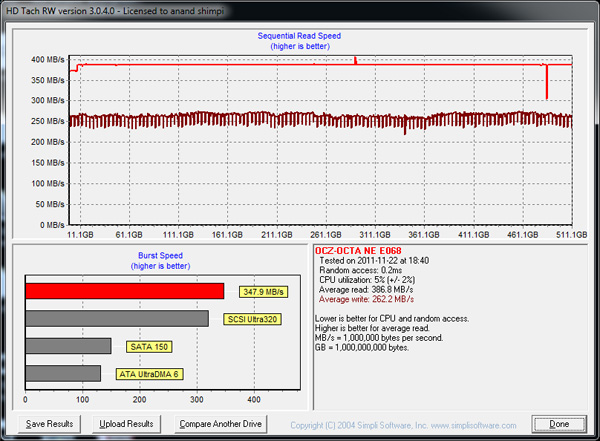The OCZ Octane Review (512GB)
by Anand Lal Shimpi on November 23, 2011 12:00 PM ESTPerformance Over Time & TRIM
Testing TRIM functionality is important because it gives us insight into the drive's garbage collection algorithms. OCZ insists the Octane has idle time garbage collection, a remnant of the original Indilinx drives, however in my testing I could not get the idle GC to do anything once I put the drive into a highly fragmented state. Let's start at the beginning though. The easiest way to ensure real time garbage collection is working is to fill the drive with data and then write sequentially across the drive. All LBAs will have data in them and any additional writes will force the controller to allocate from the drive's pool of spare area. This path shouldn't have any bottlenecks in it; the process should be seamless. As we've already seen from our Iometer numbers, sequential write performance at low queue depths is around 280MB/s. A quick HD Tach pass of a completely full drive gives us the same result:

The Octane works as expected here, but now what happens if we subject the drive to a ton of 4KB random writes? Unfortunately this is where the Octane falls short. If we just throw a few minutes of random writes, constrained to a small LBA range, at the Octane its performance hardly varies:

However once the Octane passes a threshold of fragmentation, the performance drop is considerable. Our standard test involves a 20 minute, 4KB random write across all LBAs at a queue depth of 32. A sequential write pass across the drive afterwards took place at between 2 and 7MB/s. Since our test drive was a 512GB model, there simply wasn't enough time to conduct a full pass in the course of preparing this review. Instead I did a shorter test with HD Tach to give you some indication of what happens to the Octane under a highy random load without TRIM:

Performance drops considerably. A single TRIM pass restores performance to new. I did have one TRIM test where only the latter half of the drive seemed to TRIM but I couldn't get the same result more than once. Now the question is, what does all of this mean?
If you have TRIM enabled on a desktop platform with a client (read: non-server) workload, none of this should matter to you. TRIM works and there doesn't appear to be any weird lag or bottlenecks in the GC path. If you don't have TRIM enabled (read: OS X) with a client workload, this could warrant a pass. The only reason I'm hesitant to recommend the Octane for use with a TRIM-less OS X installation is because I'm not entirely sure the drive will recover from this ultra low performance state without TRIM. Sequential writing alone may not be enough to adequately restore the Octane's performance. Normally idle GC would be enough, but it seems as if things get slow enough the drive's idle GC can't do much. I suspect all of this is stuff that OCZ can tweak via firmware, but I need more time with the drive to really be certain.
Finally if you're deploying a server with lots of random writes, the Octane isn't for you. OCZ will eventually release an Everest based drive for the enterprise, but the Octane is not that drive.










75 Comments
View All Comments
iwod - Wednesday, November 23, 2011 - link
So while hopefully pulling Seq Read Write Further until we reach the same point of the curve as Random Write, which should be fairly easy, SSD needs to Significantly improve Random ReadChloiber - Wednesday, November 23, 2011 - link
Anand - why don't you also test Random Read with a queue depth of 32? I agree that QD32 isn't as important as below-10s, but I don't quite understand why there is no QD32 Random Read but a QD32 Random Write?mino - Wednesday, November 23, 2011 - link
NAND 512GBUser Capacity 476GiB
I hope AT staff is aware that:
512GB (GigaByte) == 512*10^9 Bytes == 476*2^30 Bytes == 476 GiB (GibiByte)
If so, then what does "User capacity" mean in that table?
Provided a claimed 7% spare area, "User capacity" would be 512 GB*0.93 = 476.16 GB == 443.5 GiB.
In my humble opinion, the reality is such:
NAND Capacity is 512GiB
User Capacity is 476 GiB (== 512GB)
jwilliams4200 - Wednesday, November 23, 2011 - link
No, a 512GB drive should have 512GB of usable capacity. And the Octane apparently does (as do other 512GB SSDs).It also has 512GiB of flash memory on board.
512GiB / 512GB = 1024^3 / 1000^3 = 1.0737, which is about 7% reserved.
mino - Wednesday, November 23, 2011 - link
Yes, I suggest/expect the same thing.Now, please go and read the table at the beginning of the article which clearly states (as of now):
NAND 1TB 512GB 256GB 128GB
User Capacity 953GiB 476GiB 238GiB 119GiB
;)
jwilliams4200 - Wednesday, November 23, 2011 - link
Anand always gets his GiB / GB wrong. I don't think I have seen him get it entirely right in any article. So I tend to ignore his mistakes now. But you are correct that his NAND flash capacity row is wrong in this article. He wrote "GB" when he should have written "GiB".I was just responding to the line where you said the user capacity is 443.5 GiB (no, it is 476GiB, Anand at least got that right). Anyway, I think we are in agreement.
mino - Friday, November 25, 2011 - link
Yeah.What I do not understand why AT insists on using both GiB and GB in an article and making consistently fools of themselves by using it wrong..
If AT "named" all GiB values in that table as "GB", I would not really bother, as that is a common practice.
What always pisses me off is the smart-ass use of both *B and *iB in the same table while consistently getting it wrong one way or the other.
Why do I bother?
Because this sloppiness puts the important spare area claims into the "maybe, if they did not miscalculate" category...
Avenger762 - Wednesday, November 23, 2011 - link
I'm not sure if the OCZ name is really recovering. I have purchased many of the Vertex 30GB and Vertex 2 40GB drives for workstations in my organization as well as OCZ RAM. I had an ongoing fiasco on getting the RMA'd RAM back. In addition about 10% of the Vertex 30GB's have failed and 2 of the Vertex 2 40GB's that were purchased about 4 months ago just failed today. As soon as my supplier can get a contract with Kingston or SanDisk SSD's, I believe that I will switch over. OCZ was always good for my personal PC, but in large volumes for the organization that I work for, they fall way short.LB-ID - Wednesday, November 23, 2011 - link
...from OCZ's 3-series drives (Vertex, Agility, etc.). They were basically inoperable for a large chunk of their client base, and even after seven months now, although their current firmware is a vast improvement, issues still persist for some. Couple that with the dismissive (and sometimes worse) attitude displayed by their 'customer service', and you have a company with a badly-damaged reputation. I'll be steering clear of them for the foreseeable future, particularly with so many comparably-priced options with far better stability available from their competitors.Beenthere - Wednesday, November 23, 2011 - link
In all honesty OCZ as a company has never impressed me. I never found their tweaked RAM to be all that great. It was a niche product that eventually made them a lot of money when review sites hyped it but the performance gains were really more in benchmarks than in system performance.Then OCZ moved on to PSUs. As history has shown this has been a mixed bag for them too. Lots of QC and design issues from their suppliers didn't help. Then they bought PCPC to try and figure out how to produce quality PSUs. Today they still have a mixed bag of PSUs under the OCZ brand with only PCPCs stuff always be top quality.
Now OCZ is flooding the market with SSDs. Needless to say all SSD suppliers have had issues with the immature tech they have been dumping in the market for naive consumers to gobble up. There has been a pretty high price to pay for being naive and jumping on these half-baked SSDs, especially OCZ's.
It would appear that OCZ is trying to stay one step ahead of the competition with all sorts of variations in SSDs be it SandForce based, Revo or now Octane. This "shotgun approach" may work for sales but as we know, OCZ's SSD quality and compatibility resembles that of their RAM and PSUs... NOT very inspiring.
So the watch word is WAIT and let other folks be UNPAID Beta testers on these half-baked products - as Anand so rightly suggested.